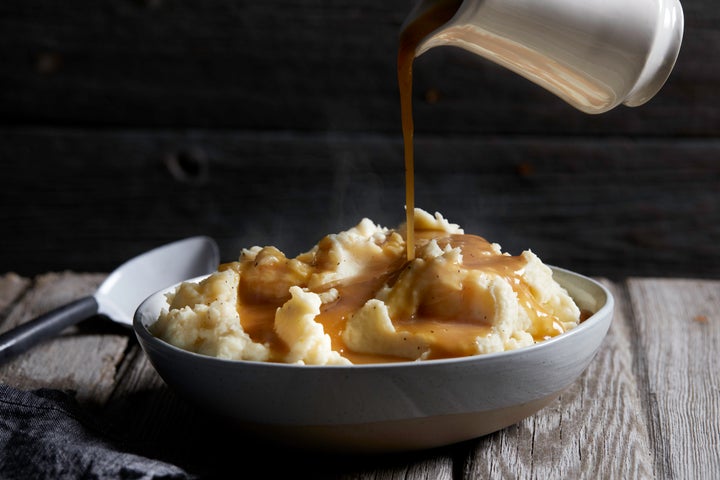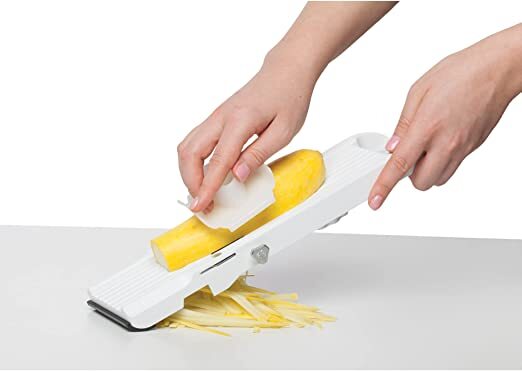When done right, mashed potatoes are creamy, fluffy, deliciously buttery and have just the right amount of salt. But despite being a relatively simple side dish with just a few ingredients, there are many ways mashed potatoes can go very wrong — and no one wants gluey, bland or otherwise sad spuds this Thanksgiving.
To help us make delicious mashed potatoes this holiday season, we’ve turned to professional chefs, who have graciously shared some of their cooking wisdom with us. Below are some of our top takeaways.
Mistake #1: Your potatoes are too wet
It sounds a little strange (considering most of us boil potatoes to make mashed potatoes), but according to chefs, more water in potatoes means you can’t add as much milk, cream and butter. When this happens, your mashed potatoes aren’t as creamy, and the texture isn’t as smooth. “You lose that velvety mouthfeel,” Chris Crary, culinary director of 1 Hotel Nashville, told HuffPost.
To prevent this from happening, Emily Mingrone, the owner of Tavern on State and Fair Haven Oyster Co., boils her potatoes whole, with the peels on (to diminish the amount of water they absorb). After they’re cooked, she peels and strains them, then puts the potatoes back on the burner over high heat for a minute or two, “just until any remaining water in the pan evaporates and you no longer can hear steam being released.”
Crary bakes, rather than boils, his potatoes in a 350-degree oven on a bed of salt for an hour (or until soft) to ensure he can pack plenty of butter and milk into his mashed potatoes without making them soupy. “If you do boil them in water, dry them out on a sheet tray in the oven before going to mash them,” he said.
Mistake #2: Letting the potatoes get too cold
“Mashed potatoes do not stay fluffy when the temperature changes,” said Vincent Menager, the VP of culinary for STK Steakhouse. This means you should avoid adding cold milk or cream to mashed potatoes, and keep them nice and warm until dinnertime. If your potatoes get cold, Menager notes that the starch in the potatoes will set and make it difficult to regain that nice, fluffy texture.
“Mashed potatoes like to stay cozy, just like us!” Menager said. To keep your potatoes warm, he recommends keeping them covered in a warm oven (turned off) or in a 140-degree bain-marie. The closer you can cook your potatoes to dinnertime, the better.
In a similar vein, you want to mash the potatoes while they’re still warm. “If the potato is cold, not only does it make it a bit more difficult to mash but you won’t get the rich, luxurious texture you’re looking for,” said Brian K. Fowler Jr., the executive chef at Blackbarn Restaurant. To fix this, he recommends bringing your potatoes back up to a simmer, then straining and mashing or whipping immediately.

Kelsey Barnard Clark, a “Top Chef” winner, owner of KBC and author of “Southern Grit: 100+ Down-Home Recipes for the Modern Cook,” also recommends mixing the potatoes before they have cooled. After boiling the potatoes, she drains them and places them on a sheet pan to dry them out in a 300-degree oven for 5 to 10 minutes. “As soon as they’re out of the oven, you want to mix them and add in your hot butter and cream mixture,” she said. “This ensures your potatoes do not get gummy.”
Mistake #3: Over-mixing the potatoes
Overworking mashed potatoes results in an unfortunate glue-like texture, and for this reason Michael DeLone, executive chef of Nunzio, recommends people stay away from electric mixers. “Unless you watch them like a hawk, mashed potatoes very quickly cross the line from fluffy and whipped to gluey and sticky,” he said. While other foods get fluffier and lighter the more they’re mixed as air is incorporated, the opposite happens for potatoes because of their high starch content.
“Over-mixing or beating makes potatoes gummy, because it breaks down the cell structure too far, releasing too much starch,” Mingrone said. “You want them to be broken down, but gently, with as little manipulation as possible.” She echoes DeLone’s recommendation of not using an electric mixer.
When potatoes are over-whipped or overcooked, the starch molecules leak out of the potato cells and result in what DeLone describes as a gummy, gluey mess. Once the potatoes are at this point, there’s no going back. “Many people think that adding more liquid (or even worse — beating more air into them) might help, but it won’t,” he said. “The addition of liquid only makes it a gummy mess sitting in a pool of melted butter or cream or water because the starch molecules, while big, don’t have the ability to absorb the liquid. There’s no bringing them back because the damage, chemically, has already been done.”
To prevent over-mixing, DeLone recommends using a potato masher (“for those who like their mashed potatoes with a few authentic lumps”) or a sturdy metal whisk for a smoother, almost pudding-like finish. “Consider it an arm workout,” he said.
Mistake #4: Adding all the liquid at once
When it’s time to add your cream (or milk) and butter, there are a few things to keep in mind to prevent over-mixing or adding too much liquid. First, Mingrone recommends warming the cream and butter together so they’re easier to incorporate into the potatoes. Warm the cream and butter in a small pot over low heat, just until the butter melts into the cream. This will help prevent over-mixing and make sure the potatoes stay warm and fluffy. “Start slowly, and add a little of the mixture at a time to make sure it’s the consistency you’re looking for, rather than adding the liquid all at once,” she said.
Even if you’re following a recipe, pay attention to the texture of the potatoes and stop before your mashed potatoes turn into potato soup. “Every potato is different!” Mingrone said. “One batch might absorb moisture faster or slower than another, so you want to add a little at a time until you achieve the desired consistency. If you pour it in all at once and it’s too much, there’s no going back.”
Mistake #5: Using milk instead of cream
For rich, creamy mashed potatoes, heavy cream is the way to go. “Always use heavy cream,” Clark said. She explained that because of its higher water content, milk yields a less creamy and less flavorful mashed potato, and tends to slightly separate from the potatoes. For rich mashed potatoes, Mingrone adds a half-stick of butter for every cup of cream.
Need help getting your potatoes ready? Try the Rotato, a $25 potato-peeling tool that’s recommended by both chefs and HuffPost Shopping editors. It’s currently 20% off at Amazon.
HuffPost may receive a share from purchases made via links on this page.
HuffPost receives a share from retailers on this page. Every item is independently selected by the HuffPost Shopping team. Prices and availability are subject to change.

